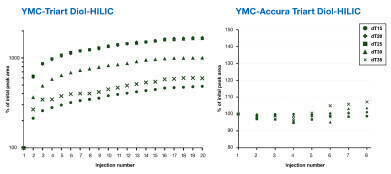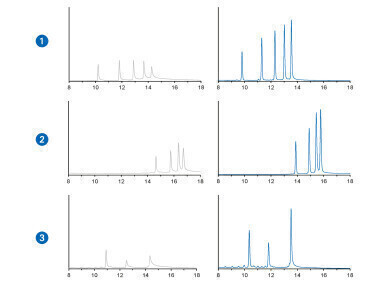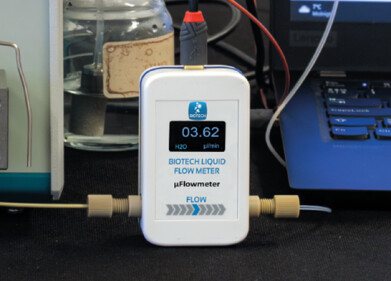-
 Figure 1: Consecutive injections of a mixture of dT 15–35 until conditioning is achieved using a conventional YMC-Triart Diol-HILIC column (left, [1]) and a YMC-Accura Triart Dio-HILIC (right, [2]) and two different bioinert systems.
Figure 1: Consecutive injections of a mixture of dT 15–35 until conditioning is achieved using a conventional YMC-Triart Diol-HILIC column (left, [1]) and a YMC-Accura Triart Dio-HILIC (right, [2]) and two different bioinert systems. -
 Figure 2: Analysis of dT15-35 (1), dT40-100 (2) and rU15-30 (3) using a regular YMC-Triart Diol-HILIC (left, analogous to [1]) and a bioinert coated YMC-Accura Triart Diol-HILIC (right, [2]) and a bioinert system.
Figure 2: Analysis of dT15-35 (1), dT40-100 (2) and rU15-30 (3) using a regular YMC-Triart Diol-HILIC (left, analogous to [1]) and a bioinert coated YMC-Accura Triart Diol-HILIC (right, [2]) and a bioinert system.
HPLC, UHPLC
HILIC analysis of oligonucleotides using bioinert columns
Feb 21 2023
Oligonucleotides have become more important for medical applications, currently they are used to treat several diseases. Therefore, robust and highly sensitive analytical methods are required. Ion pair reversed phase liquid chromatography (IP-RP) and anion exchange chromatography (AEX) seem to be the gold standards for the characterisation of oligonucleotides and their by-products. In addition to AEX, hydrophilic interaction liquid chromatography (HILIC) can provide an alternative approach due to the highly polar nature of oligonucleotides. The materials conventionally used for tubing and column hardware pose a special challenge for the analysis of oligonucleotides.
Limitations of stainless steel standard columns
Stainless steel provides mechanical resilience and compatibility with most solvents although many eluents such as methanol or acetonitrile can cause corrosion. The resulting positively charged surface can lead to metal leaching as well as undesired ionic interactions with the analytes. Electron rich analytes as oligonucleotides can be irreversibly adsorbed. This non-specific adsorption has a negative influence on recovery and peak shape. This effect is even more critical when working at low to neutral pH, as metals are more electropositive under these conditions.
Bioinert columns offer a robust and simple solution
To overcome this problem HPLC systems and columns can be passivated with strong acids or pre-conditioned with a similar sample. However, these procedures are time consuming and require repeated application. Furthermore, a change of sample can lead to nonspecific adsorption again. A much more robust and simple solution is to use a bioinert system and column hardware. Specifically, the column hardware needs to be paid attention, as it represents more than 70% of the surface that the analytes are in touch with. Consequently, a bioinert column body and frits will bring a distinct improvement in performance. Therefore, YMC provides the bioinert YMC-Accura Triart series of columns which have a bioinert coating on the column body and frits.
In a new application note three different oligonucleotide mixtures (dT15-35 and dT40-100 deoxythymidine oligonucleotides and rU15-30 RNA oligonucleotides) were analysed using a YMC-Triart Diol HILIC column with conventional stainless steel hardware and the bioinert column option YMC-Accura Triart Diol-HILIC column. The comparison demonstrates that using a bioinert coated column results in higher peak areas, higher intensities and less tailing.
Pre-conditioning remarkably reduced
Pre-conditioning is a typical procedure when working with stainless steel columns. Using a bioinert column such as YMC-Accura Triart usually achieves great performance from the first injection, at least when working with an IP-RP phase. However, HILIC phases still need some pre-conditioning even when a bioinert column is used. Figure 1 shows the number of injections of short DNA oligonucleotides needed until full conditioning is achieved. Even though these bioinert columns still need conditioning the number of injections is remarkably reduced. While 20 injections are necessary for the stainless steel column, the YMC-Accura column is already conditioned after 8 injections, with very little difference (less than 10%) between initial and final peak areas.
Digital Edition
Chromatography Today - Buyers' Guide 2022
October 2023
In This Edition Modern & Practical Applications - Accelerating ADC Development with Mass Spectrometry - Implementing High-Resolution Ion Mobility into Peptide Mapping Workflows Chromatogr...
View all digital editions
Events
ACS National Meeting - Fall 2024
Aug 18 2024 Denver, CO, USA
Sep 04 2024 Chiba, Tokyo, Japan
Sep 04 2024 University of Warwick, Coventry, UK
Sep 10 2024 Rockville, MD, USA
Plastics Recycling World Expo Europe
Sep 11 2024 Brussels, Belgium













